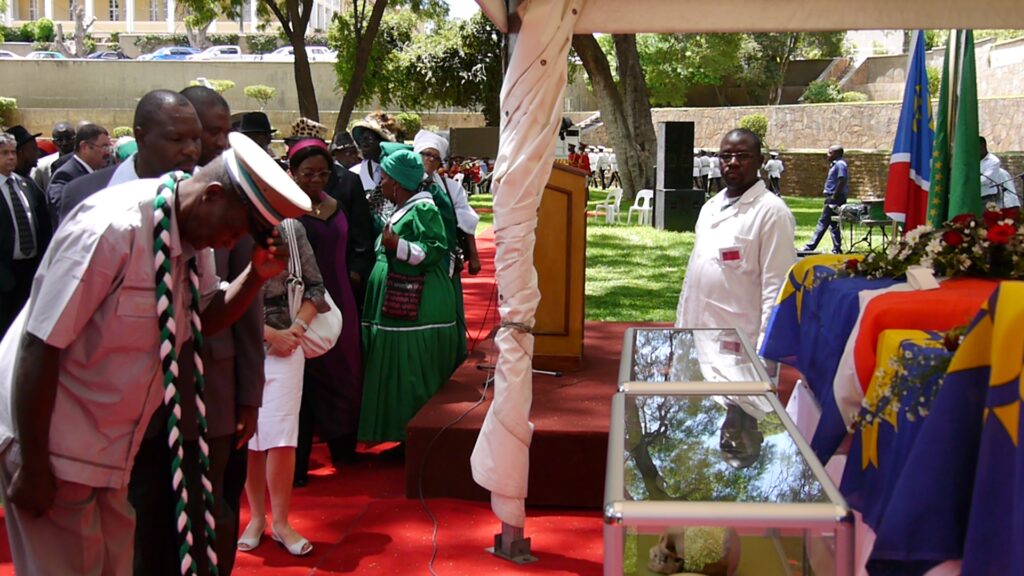By: Larissa Förster, Dag Henrichsen, Holger Stoecker
Originally Published 6 May 2016 [LINK TO ORIGINAL]
In early December 1884, the German scientist Waldemar Belck arrived in Walvis Bay with three skeletons in order to ship them to Berlin. The scant information available tells us that he had robbed them from graves in the lower Kuiseb. They belonged to three men who had died on 30 March that year during a cattle raid by Herero at a place called ǁKharabes close to Rooibank. A few weeks later the men had been buried by Kaptein Jan Jonker Afrikaner.
Months later word of Belck´s arrival in Walvis Bay spread quickly. He reported that the – unnamed – daughter of one of the deceased men, Jacobus Hendrick, demanded her father´s remains. Instead of complying with her demand Belck gave her the scull of Jacobus !Garisib, another of the men who had died during the raid. He then shipped the remains, including those of a third man, Oantab, to Berlin. Here they entered a large collection of human remains build up by German scientists for the purpose of “scientific research” into “human races”. They remain in the collection until today.
Belck had been a member of one of the so-called Lüderitz expeditions and had witnessed in August 1884 the hoisting of the German flag in Angra Pequena/Lüderitzbucht, on occasion of proclaiming that part of Namibia a German colony. He had brought with him a photo apparatus and anthropometric instruments. During his initial travels in southern Namibia he “measured” and otherwise described the physical appearances of – predominately – Nama-Oorlam men, amongst them Kaptein Joseph Fredericks of Bethany. He continued such activities in the Walvis Bay area and later, in March 1885, also at Otjitambi near Kamanjab. Here he had entered into negotiations, on behalf of the merchant Adolf Lüderitz, with Kaptein Cornelius Swartbooi and his Raad in obtaining land and mining concessions. Once back in Berlin, his anthropometric data and the three skeletons were “scientifically” discussed amongst physical anthropologists.

Scientists in all European metropoles had embarked in the late 19th century on large-scale “acquisitions” of human remains from around the world and also from pre-historic European grave sites. They argued that these “collections” and the accumulated anthropometric data (including descriptions of skin and eye colour or hair samples) formed a “necessary” basis for identifying “races” – an ideology deeply flawed with racist assumptions and implicated in the formation of a racialized hierarchy and ideology underpinning the colonial project.
The authors came across the names and details of the three deceased men and the grave robbery by Belck in publications of the Berlin institution holding their remains and in documents from various other archives. We believe that their descendants should be traced.
Jacobus Hendrick is reported to have been the son-in-law of Samuel Gertze, himself a well known Rhenish Mission preacher and personality at the time. Belck also mentioned Hendrick as having been a former school teacher in Otjimbingue, and being a member of the “Zwartbooi tribe”.
Jacobus !Garisib is said to have been a cousin of Jacobus Hendrick and “possibly” also a “Zwartbooi”.
Oantab is said to have been guarding the stock of Jacobus Hendrick, with no additional information on his background provided.
No additional information on the individual biographies of these men seems to have survived in the archives.
Jacobus Hendrick and his death was still remembered by people living in the lower Kuiseb in the 1960s. For example, in 1969 the Topnaar Voorman Jacobus Stevenson (“Argyll”) reported on the death of two “Hendrik brothers” at ǂArexa!nanis, another name, it seems, for ǁKharabes. Stevenson then also said that a sister of the brothers, Hanna Hendricks, was married to Nicolaas ǁKeiseb.
We do hope that the historical biographical information provided here could trigger memories and direct us in tracing any descendants of the men whose remains continue to be part of a scientific collection in Berlin instead of resting, as they already did, in Namibian soil.
